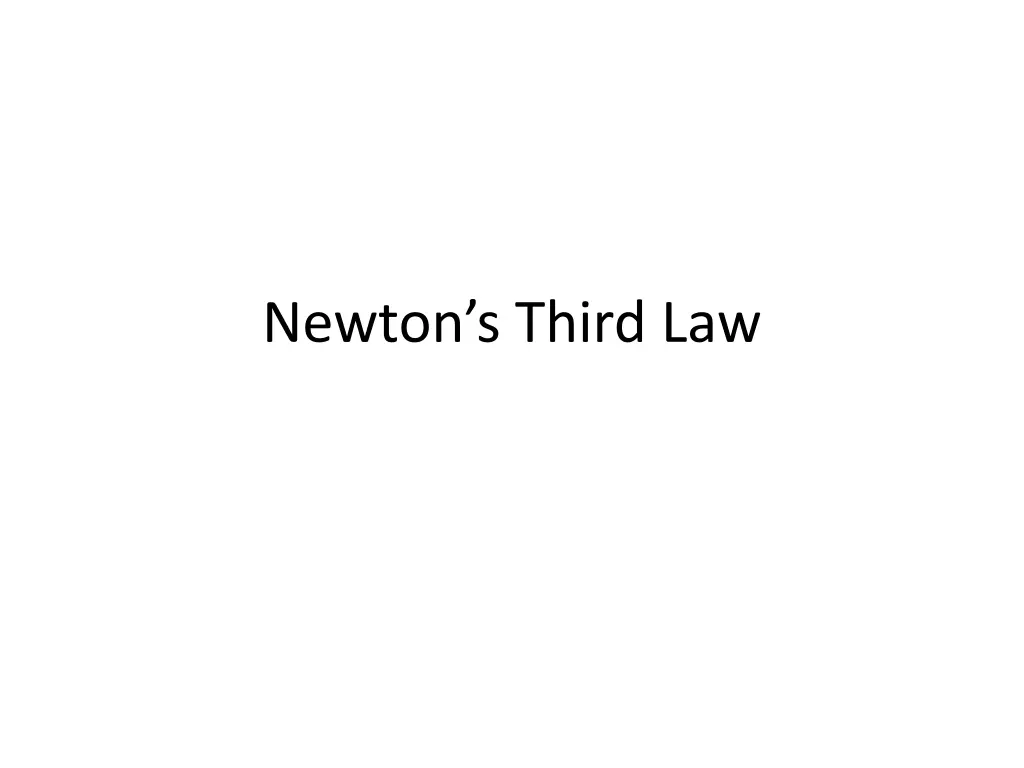
Understanding Newton's Third Law of Motion
Explore the principles of Newton's Third Law of Motion which states that for every action, there is an equal and opposite reaction. Discover examples illustrating this law and learn how forces influence the motion of objects.
Download Presentation

Please find below an Image/Link to download the presentation.
The content on the website is provided AS IS for your information and personal use only. It may not be sold, licensed, or shared on other websites without obtaining consent from the author. If you encounter any issues during the download, it is possible that the publisher has removed the file from their server.
You are allowed to download the files provided on this website for personal or commercial use, subject to the condition that they are used lawfully. All files are the property of their respective owners.
The content on the website is provided AS IS for your information and personal use only. It may not be sold, licensed, or shared on other websites without obtaining consent from the author.
E N D
Presentation Transcript
Newtons Third Law of Motion Whenever one object exerts a force on a second object, the second object exerts an equal and opposite force on the first. To every action there is an equal and opposite reaction F(AB) = - F(BA) Forces come in pairs. In nature there is no single force (all by itself).
Examples I exert a force on a desk with my foot and the desk exerts a force back on my foot. ( I kick a desk and the desk kicks me back. ) A hammer exerts a force on a nail and the nail exerts a force back on the hammer.
Force on and by A force influences the motion of an object only when it is applied on that object. A force exerted by a body does not influence that body (itself); it only influences the OTHER body on which it is exerted. F(AB) = - F(BA)
Group Activity 1. Explain walking forward on East Bottom. 2. Explain birds flying south. 3. Explain a rocket lifting off Cape Canaveral. 4. A person throws a package out of a boat (initially at rest). 5. A bat exerts a 50 N force on a baseball. 6. An inflated, but untied, balloon flies off. 7. Earth exerts gravitation on the moon.



![textbook$ What Your Heart Needs for the Hard Days 52 Encouraging Truths to Hold On To [R.A.R]](/thumb/9838/textbook-what-your-heart-needs-for-the-hard-days-52-encouraging-truths-to-hold-on-to-r-a-r.jpg)
![[PDF] DOWNLOAD READ Diagnosis Solving the Most Baffling Medical Mysterie](/thumb/9855/pdf-download-read-diagnosis-solving-the-most-baffling-medical-mysterie.jpg)
![Read ebook [PDF] Infiammazione Zero La Promessa Della Dieta Antinfiammatoria](/thumb/9900/read-ebook-pdf-infiammazione-zero-la-promessa-della-dieta-antinfiammatoria.jpg)

![[PDF⚡READ❤ONLINE] Zen Mind, Beginner's Mind: 50th Anniversary Edition](/thumb/20459/pdf-read-online-zen-mind-beginner-s-mind-50th-anniversary-edition.jpg)
![READ⚡[PDF]✔ Yup I'm Dead...Now What? The Deluxe Edition: A Guide to My Life Info](/thumb/20463/read-pdf-yup-i-m-dead-now-what-the-deluxe-edition-a-guide-to-my-life-info.jpg)
![get⚡[PDF]❤ The Healthiest People on Earth: Your Guide to Living 10 Years Longer](/thumb/20470/get-pdf-the-healthiest-people-on-earth-your-guide-to-living-10-years-longer.jpg)
![❤Book⚡[PDF]✔ Fool Me Once: Should I Take Back My Cheating Husband?](/thumb/20473/book-pdf-fool-me-once-should-i-take-back-my-cheating-husband.jpg)
![Read⚡ebook✔[PDF] Blood of the Provinces: The Roman Auxila and the Making of Pro](/thumb/20539/read-ebook-pdf-blood-of-the-provinces-the-roman-auxila-and-the-making-of-pro.jpg)
![[PDF⚡READ❤ONLINE] In Ruins: A Journey Through History, Art, and Literature](/thumb/20543/pdf-read-online-in-ruins-a-journey-through-history-art-and-literature.jpg)



![[PDF⚡READ❤ONLINE] Tutankhamun's Trumpet: Ancient Egypt in 100 Objects from the](/thumb/20549/pdf-read-online-tutankhamun-s-trumpet-ancient-egypt-in-100-objects-from-the.jpg)
![❤[PDF]⚡ Civil War Talks: Further Reminiscences of George S. Bernard and His Fel](/thumb/20551/pdf-civil-war-talks-further-reminiscences-of-george-s-bernard-and-his-fel.jpg)
![READ⚡[PDF]✔ European Mail Armour: Ringed Battle Shirts from the Iron Age, Roman](/thumb/20552/read-pdf-european-mail-armour-ringed-battle-shirts-from-the-iron-age-roman.jpg)
![[PDF⚡READ❤ONLINE] Black Hole Astrophysics: The Engine Paradigm (Springer Praxis](/thumb/21503/pdf-read-online-black-hole-astrophysics-the-engine-paradigm-springer-praxis.jpg)
![❤[PDF]⚡ Planetary Ring Systems (Springer Praxis Books)](/thumb/21506/pdf-planetary-ring-systems-springer-praxis-books.jpg)
![READ⚡[PDF]✔ The Earth in Context: A Guide to the Solar System (Springer-Praxis S](/thumb/21508/read-pdf-the-earth-in-context-a-guide-to-the-solar-system-springer-praxis-s.jpg)
![❤Book⚡[PDF]✔ Spaceplane HERMES: Europe's Dream of Independent Manned Spaceflight](/thumb/21517/book-pdf-spaceplane-hermes-europe-s-dream-of-independent-manned-spaceflight.jpg)